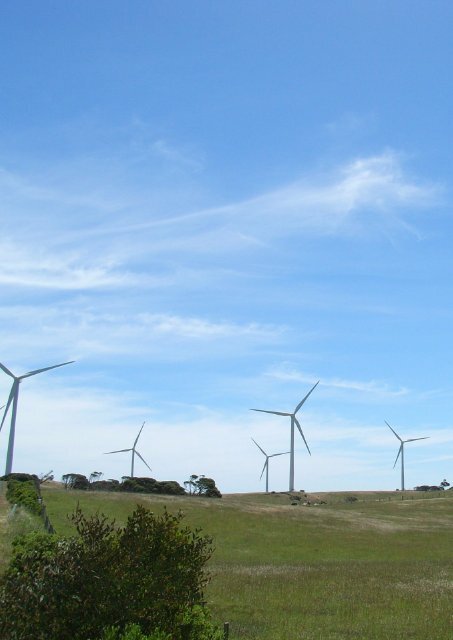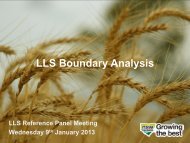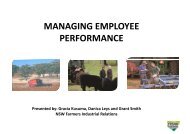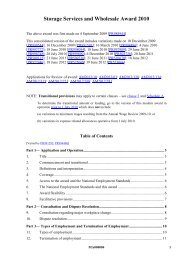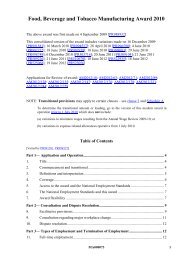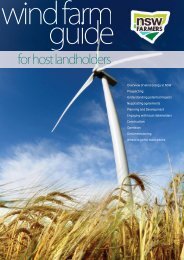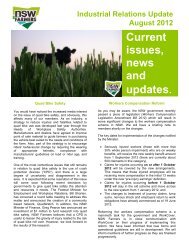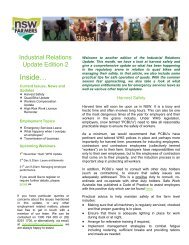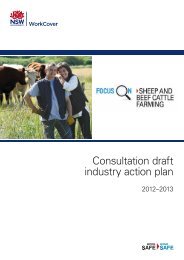Chapter 5 – Understanding the potential impacts - NSW Farmers ...
Chapter 5 – Understanding the potential impacts - NSW Farmers ...
Chapter 5 – Understanding the potential impacts - NSW Farmers ...
You also want an ePaper? Increase the reach of your titles
YUMPU automatically turns print PDFs into web optimized ePapers that Google loves.
Wind Farm Guide for Host Landholders<br />
14
<strong>Understanding</strong> <strong>the</strong> <strong>potential</strong> <strong>impacts</strong> 5<br />
This Section aims to outline some <strong>impacts</strong> that may result from<br />
wind farm developments, keeping in mind that <strong>impacts</strong> will<br />
vary between developments.<br />
A visit to an operational wind farm can be an extremely<br />
worthwhile exercise for landholders to get a first-hand<br />
experience of a wind farm and meet host landholders who have<br />
been through <strong>the</strong> development process.<br />
Figure 7<br />
Sheep grazing near turbines, Clements Gap Wind<br />
Farm, SA 8<br />
5.1.1 Land use<br />
Figure 6 Wind farm site visit 7<br />
5.1 Impact on farming activities<br />
Host landholders generally find that wind farm development<br />
does not significantly impact farm operations. Some common<br />
considerations are discussed below.<br />
The land required for wind farm developments is generally<br />
minimal. Land is required for <strong>the</strong> tower (about 100 m2 each)<br />
and access roads (usually gravel, between 6 and 12 m in width)<br />
running between each turbine. Depending on <strong>the</strong> development<br />
a substation may also need to be established (<strong>potential</strong><br />
footprint up to 1 Ha). Substations will be fenced off to meet<br />
safety regulation.<br />
Electrical cabling is buried underground (usually alongside<br />
access roads).<br />
Remuneration from hosting wind turbines generally outweighs<br />
any loss of production. Landholders can negotiate with<br />
developers ways to minimise production losses (such as by<br />
siting turbines and roads on less productive areas of <strong>the</strong> farm).<br />
Wind Farm Guide for Host Landholders<br />
15
Risks associated with fire normally have to be addressed in<br />
<strong>the</strong> project Environmental Impact Statement (EIS) and in<br />
Environmental Management Plans produced as a requirement<br />
of planning approval. Developers may also seek input from <strong>the</strong><br />
<strong>NSW</strong> Rural Fire Service (RFS) to develop a wind farm design<br />
which minimises on-farm fire risks and is consistent with<br />
regional Bushfire Risk Management Plans.<br />
5.1.5 Management issues<br />
During <strong>the</strong> construction phase <strong>the</strong>re may be short-term<br />
land access restrictions. Stock will need to be excluded from<br />
construction areas and new fencing may be required. This can,<br />
however, provide an opportunity for development of laneway<br />
systems for stock movement.<br />
Figure 8 Building of substation, Bungendore, <strong>NSW</strong> 9<br />
5.1.2 Water use<br />
Wind farms do not use water nor is <strong>the</strong>re any significant risk of<br />
ground water contamination.<br />
5.1.3 Aerial agriculture<br />
Wind turbines may, in some circumstances, affect aerial<br />
application of fertiliser and chemicals. Pilots may not be<br />
willing to operate in certain areas depending on:<br />
• <strong>the</strong> number of turbines;<br />
• <strong>the</strong> distance between turbines;<br />
• <strong>the</strong> landscape; and<br />
• whe<strong>the</strong>r <strong>the</strong> turbines are operating.<br />
An agricultural aviation assessment by <strong>the</strong> developer can<br />
determine <strong>the</strong> effect on aerial agriculture. If capacity is<br />
reduced landholders may be able to negotiate compensation<br />
from developers to account for additional costs associated<br />
with ground spreading/spraying.<br />
The construction phase will involve a large number of vehicles<br />
entering <strong>the</strong> property and without proper controls <strong>the</strong>re is<br />
an increased risk to farm biosecurity and weed incursions.<br />
Landholders should <strong>the</strong>refore develop clear controls for<br />
vehicle access (including contractors) during negotiation of<br />
<strong>the</strong> lease agreement.<br />
Host landholders generally find that once a wind farm is<br />
operational livestock quickly become accustomed to <strong>the</strong><br />
moving turbines and are happy to graze in <strong>the</strong>ir vicinity and<br />
seek shelter in <strong>the</strong> shadows. In some instances activities that<br />
might attract birdlife (eg. lambing and calving) are, however,<br />
not able to occur in areas close to turbines.<br />
For more information on construction <strong>impacts</strong>, see Section 8.<br />
5.1.4 Fire management<br />
Wind turbines may also reduce aerial access for bushfire<br />
management, although this risk of often offset by improved<br />
ground access.<br />
Figure 9 Laying cable, Bungendore, <strong>NSW</strong> 10<br />
16 Wind Farm Guide for Host Landholders
Figure 10 Capital Wind Farm, <strong>NSW</strong> 11<br />
5.2 Impact on amenity<br />
Wind farms are highly visible and can attract a great deal of<br />
attention, both positive and negative due to <strong>the</strong>ir visibility in<br />
<strong>the</strong> landscape. The following section outlines <strong>the</strong> effects of<br />
wind farms and amenity <strong>impacts</strong>.<br />
Figure 11 Codrington Wind Farm, Victoria 12<br />
5.2.1 Visual<br />
Over <strong>the</strong> years, wind turbines have been built higher, with<br />
current projects under development involving towers of up to<br />
120 m and height to blade tip of up to160 m.<br />
The grouping of turbines, positioning on hill slopes, and<br />
typical placement in an area void of o<strong>the</strong>r types of vegetation<br />
can affect <strong>the</strong> visibility of wind farms within <strong>the</strong> landscape.<br />
Typically in communities, some people consider wind turbines<br />
to be a positive addition to <strong>the</strong> landscape whereas o<strong>the</strong>rs view<br />
<strong>the</strong>m more negatively.<br />
Wind Farm Guide for Host Landholders<br />
17
Shadow flicker<br />
The moving blades of wind turbines cast moving shadows that<br />
when viewed through a stationary constrained opening such<br />
as a window appears as a flicker. This is commonly referred<br />
to as shadow flicker and when <strong>the</strong> sun is low in <strong>the</strong> sky <strong>the</strong><br />
effect of shadow flicker increases. It is generally accepted that<br />
shadow flicker can only occur within 1 km. 13<br />
5.2.2 Dust<br />
As wind farm development locations are usually exposed<br />
windy sites, <strong>the</strong>re is <strong>potential</strong> for temporary dust nuisance<br />
during construction, and from excavated material left on site.<br />
Developers can mitigate dust generation by spraying <strong>the</strong><br />
area with water (accessed from <strong>the</strong> site or imported). Ano<strong>the</strong>r<br />
<strong>potential</strong> mitigation measure is to carefully spread excavated<br />
material, and seed disturbed areas as soon as possible.<br />
5.2.3 Noise<br />
Wind turbines generate noise via movement of <strong>the</strong> blades and<br />
internal moving parts. In recent times technical improvements<br />
have reduced noise levels. By reducing <strong>the</strong> energy lost to<br />
noise, turbines have become more efficient in converting wind<br />
into electricity.<br />
Currently <strong>NSW</strong> uses <strong>the</strong> South Australian Wind Farms<br />
Environmental Noise Guidelines (2003) in <strong>the</strong> assessment<br />
process for approving wind farms. Under <strong>the</strong>se Guidelines<br />
noise levels should not exceed 35 A-weighted decibels or<br />
<strong>the</strong> background noise by more than 5 A-weighted decibels,<br />
whichever is greater for all relevant receivers at each integer<br />
wind speed from cut in to rated power of <strong>the</strong> turbine. This is<br />
because <strong>the</strong> background noise will change with increasing<br />
wind speed. This is one of <strong>the</strong> strictest limits in <strong>the</strong> world.<br />
The noise threshold limits apply to surrounding landholders<br />
that are not associated with <strong>the</strong> wind farm (referred to as<br />
‘receivers’). Figure 12 provides a comparative analysis of <strong>the</strong><br />
threshold with o<strong>the</strong>r typical noise levels.<br />
The Draft <strong>NSW</strong> Planning Guidelines: Wind Farms 14 also use <strong>the</strong><br />
35dBA criteria. The remainder of <strong>the</strong> criteria should be added<br />
i.e. “or <strong>the</strong> background noise by more than 5 A-weighted<br />
decibels, whichever is greater at all relevant receivers at each<br />
integer wind speed from cut in to rated power of <strong>the</strong> turbine”.<br />
Decibels<br />
Equivalent<br />
140 Threshold of pain<br />
135<br />
130<br />
125 Jet taking off<br />
120<br />
115<br />
110 Rock concert<br />
105<br />
100<br />
95 Jackhammer near operator<br />
90<br />
85<br />
80<br />
75 Busy city street near curbside<br />
70<br />
65<br />
60 Busy office<br />
55<br />
50<br />
45<br />
40 Quiet suburban area<br />
35 Windfarm Guidelines Baseline<br />
30 Quiet countryside<br />
25<br />
20 Inside bedroom - windows closed<br />
15<br />
10<br />
05<br />
0 Threshold of hearing<br />
Figure 12 Relative noise levels 15<br />
18 Wind Farm Guide for Host Landholders
5.3 Health <strong>impacts</strong><br />
There have been claims that noise and vibrations from<br />
wind farms make people sick (‘wind turbine syndrome’ or<br />
‘vibroacoustic disease’).The Australian National Health<br />
and Medical Research Council (NHMRC) released a public<br />
statement in 2010 reporting no published scientific evidence<br />
to positively link wind turbines with adverse health effects.<br />
Currently, <strong>the</strong> NHMRC is conducting a fur<strong>the</strong>r review of<br />
scientific literature, <strong>the</strong> outcomes of which will provide<br />
guidance for public health policy and expected research. The<br />
reference group undertaking this review is likely to conclude<br />
its work by late 2013.<br />
Wind farm lease agreement negotiations and local community<br />
pressures may cause stress and anxiety during <strong>the</strong> wind farm<br />
development process. Specialised support for rural <strong>NSW</strong><br />
residents is available through <strong>the</strong> <strong>NSW</strong> Department of Primary<br />
Industry’s Rural Support Program. The Rural Support Program<br />
aims to build <strong>the</strong> capacity and resilience of rural communities<br />
through improved knowledge, skills and practices to enable<br />
better management of future environmental and o<strong>the</strong>r<br />
adverse events. Contact details for <strong>the</strong> Program are at <strong>the</strong> end<br />
of this Guide.<br />
5.5 Positive <strong>impacts</strong><br />
It is important that landholders weigh up <strong>the</strong> predominately<br />
negative <strong>impacts</strong> discussed above with <strong>the</strong> positive <strong>impacts</strong><br />
listed below:<br />
• Financial remuneration (Section 6.5);<br />
• New access roads can provide improved access for farm<br />
management and fire;<br />
• Vegetation offset requirements could mean planting or<br />
o<strong>the</strong>r rehabilitation is undertaken on <strong>the</strong> landholders<br />
property;<br />
• Community benefits from increased jobs and economic<br />
activity; and<br />
• Environmental benefits from CO2 emission reduction.<br />
O<strong>the</strong>r resources for anyone who may be distressed also<br />
include Lifeline 131 114, Mensline 1300 789 978 and Rural<br />
Mental Health Support 1800 201 123.<br />
5.4 Social/community <strong>impacts</strong><br />
Some developments may experience community opposition.<br />
Early consultation and engagement with <strong>the</strong> community to<br />
build awareness of <strong>the</strong> project can help effectively resolve<br />
concerns. Fur<strong>the</strong>r information about engagement with local<br />
stakeholders is provided in Section 7.2.<br />
At a general level <strong>the</strong>re are strong levels of community<br />
support for wind farms in rural Australia flowing from,<br />
amongst o<strong>the</strong>r things, <strong>the</strong> employment benefits that result<br />
from wind energy developments.<br />
Wind Farm Guide for Host Landholders<br />
19


